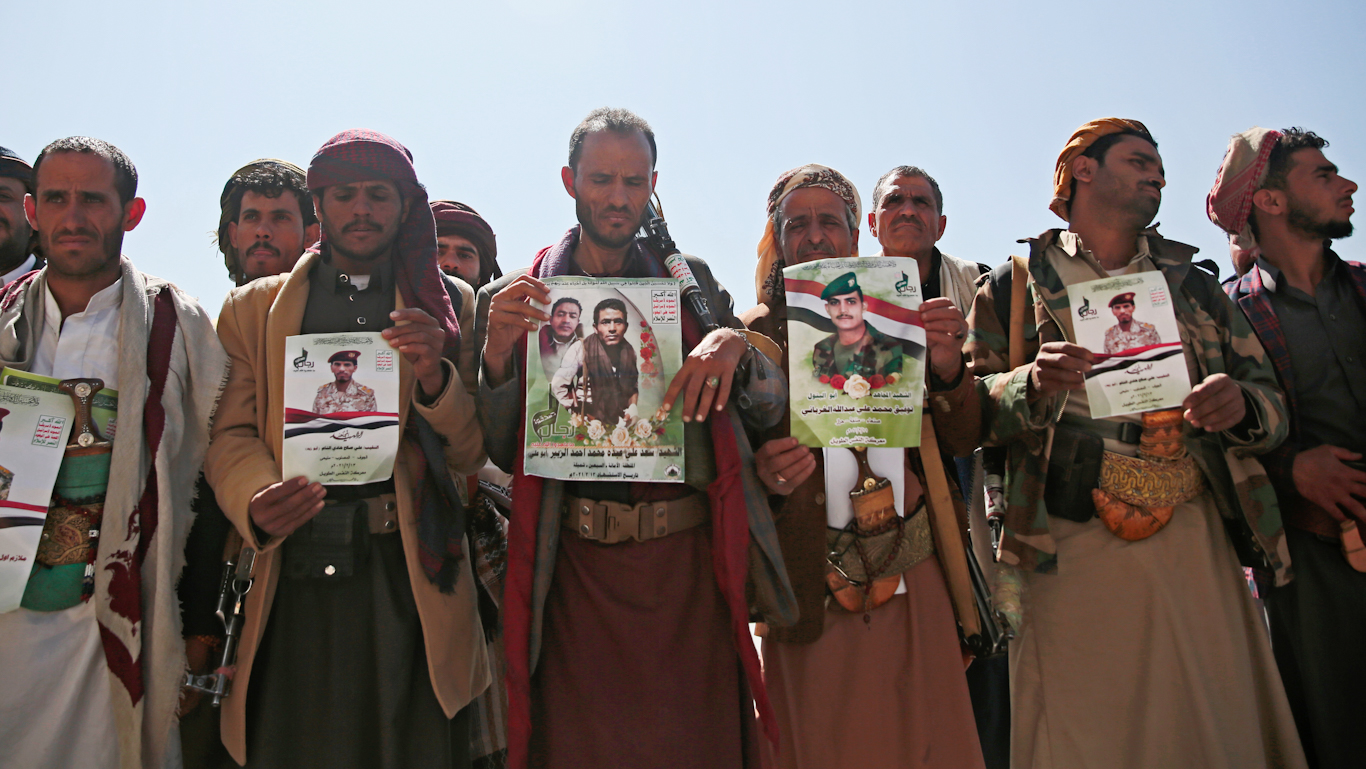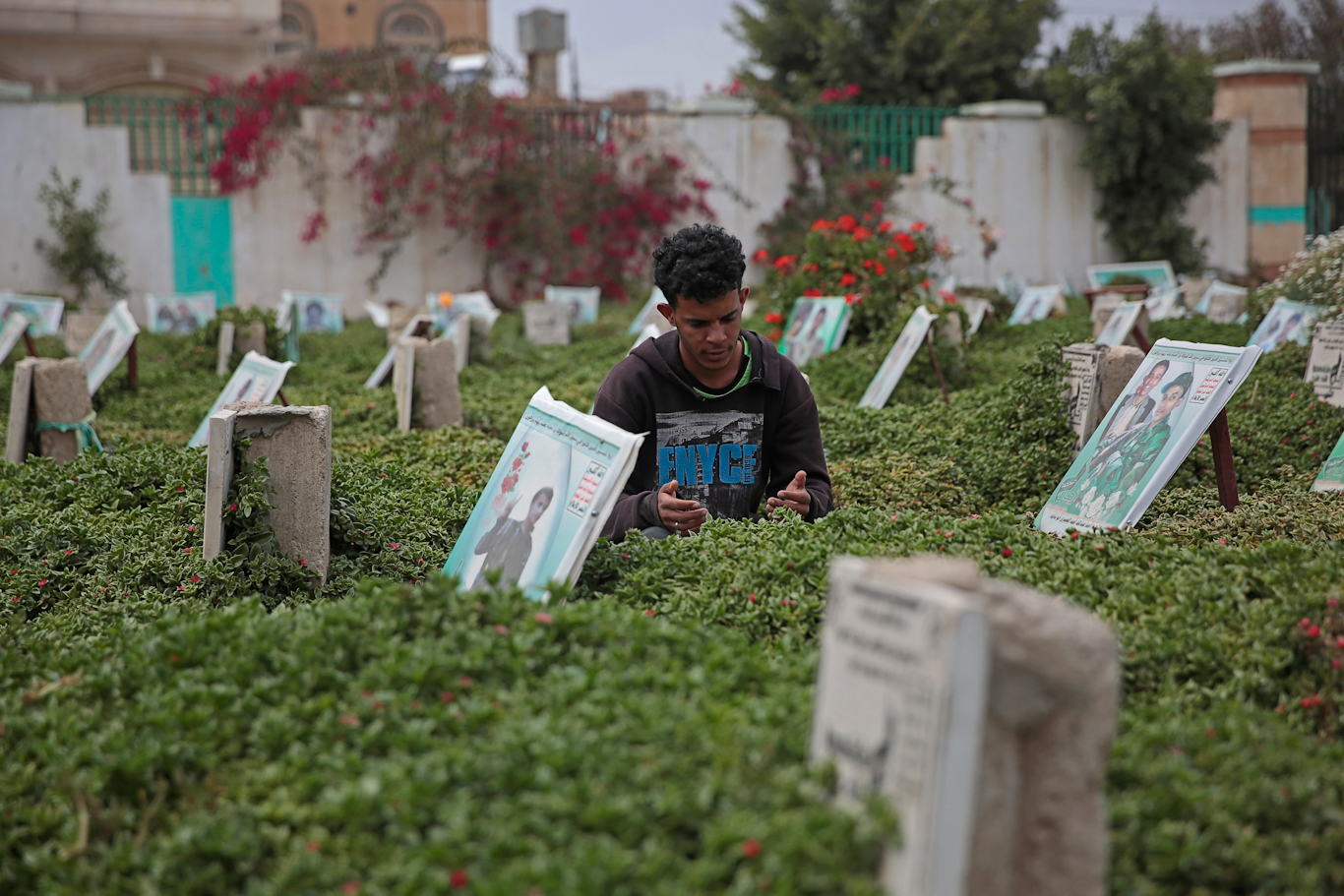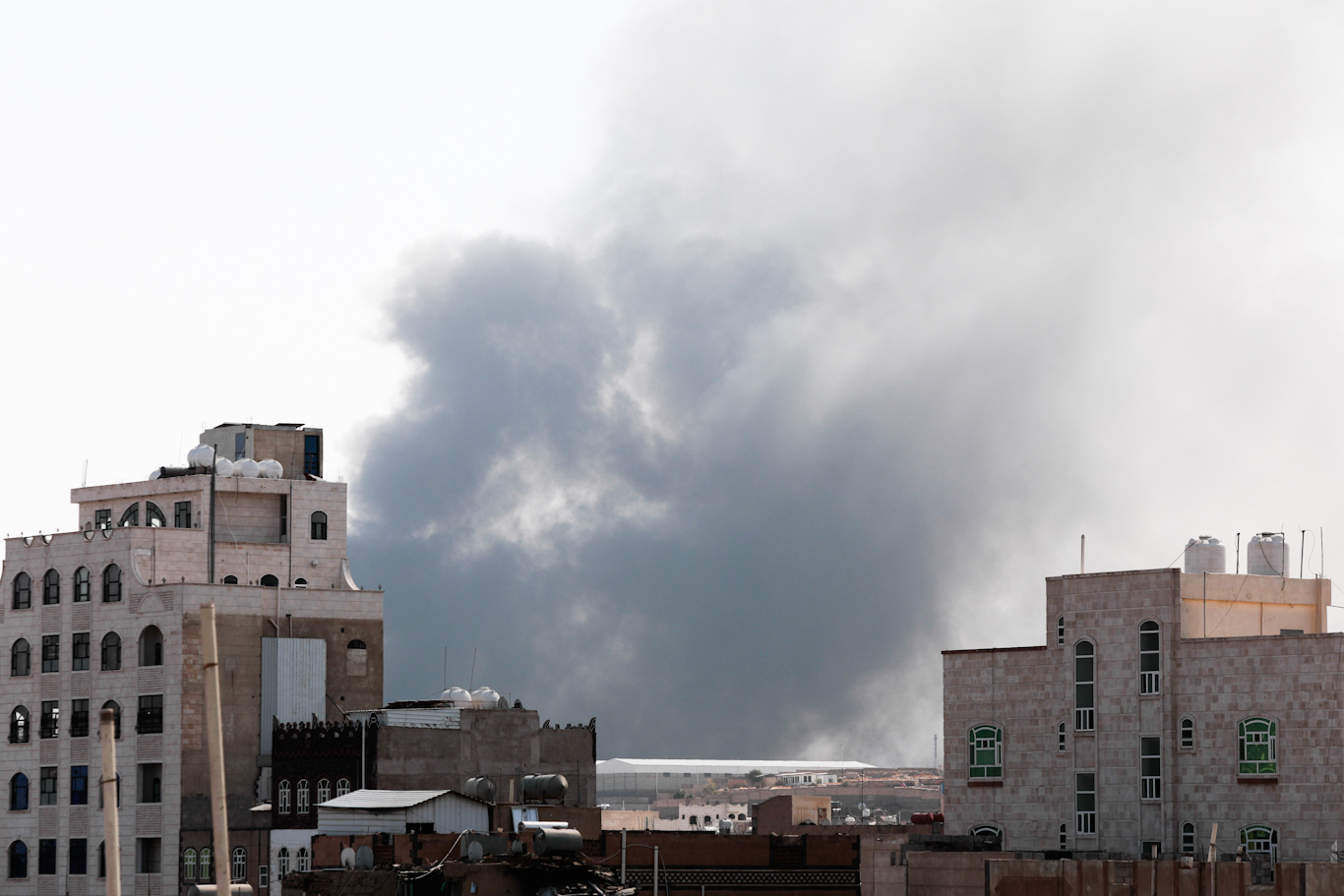
By Ahmed Abdulkareem
Having all but given up on the prospect of peaceful settlement under the administration of Joe Biden, the Houthis are now betting it all on retaking Yemen’s oil-rich Marib province from Saudi Arabia.
MARIB, YEMEN — Overcoming a rugged and Sahara-like desert climate and under the constant fire of Saudi warplanes, Tawfiq Hassan, a third-term Sufi law school student, along with a cadre of other young Yemeni fighters, partook in the recent liberation of the Nakhla Valley near the western gate of the city of Marib.
“To recapture Marib and its natural resources is the last chance to secure its oil,” Tawfiq told MintPress. But for Khaled Mudaher, a soldier in Yemen’s Republican Guard, liberating Marib is a sacred patriotic duty. ”They bomb us, kidnap our women, block medicine and fuel, and steal our wealth,” Mudaher lamented.
Battles over Yemen’s oil-rich Marib province, which lies only 100 kilometers east of the capital Sana’a, have raged on since 2015 when the war began. The clashes pit Saudi-led Coalition soldiers and their Salafist militant allies against Yemeni forces supported by the Houthis as well as partisans from local tribes. Those clashes have become more fierce as the war and Saudi-imposed blockade approach six years’ duration on March 26, and amid a new push by Sana’a to liberate the last strongholds of the Saudi-led Coalition from Riyadh’s control.
For the past few months, Yemeni forces have fought a grueling ground campaign to recapture strategic points on Marib battlefields, including villages and military positions surrounding Marib city. Across the western and north-western oil-rich fronts, fierce clashes have erupted as more and more local tribes join battles to reclaim ancient landmarks with evocative names from Saudi forces. From The Thunders and The Hunter’s Birthmark to the strategic Shower Heights overlooking the Dish of Jinn and the tribal Balkan Mountains near the famous Marib Dam itself, long battles slog on, peppered with small but frequent hit-and-run battles in outlying districts, including Altielat Alhamra. Coalition forces for their part claim that they are thwarting ٍSana’a’s advance and have recaptured many of the liberated sites.
Escalation born of desperation
The recent escalation is not only a result of the brutal siege and bombardment of Yemen, which has bred a communal sense of desperation, but it is also born from a recognition that there are no real intentions on behalf of the Saudis or Americans to stop the war. That sense of hopelessness has had fuel poured onto it in the form of violent acts carried out by Saudi forces that violate the core tenants and mores of Yemeni people, not to mention their very dignity.
On February 1, Saudi-backed militants raided the homes of an unknown number of displaced families in Marib and kidnapped seven women who were allegedly then sold to Saudi Arabia. Five of the women were kidnapped on a Saturday night and, as locals were still reeling, the militants returned the next morning and kidnapped two more women by force. The news quickly spread across Yemen and anger mounted, sparking dozens of protests against Saudi forces. Major tribes in Marib, who for decades have maintained either neutrality or loyalty to Saudi Arabia, held a meeting in Sana’a to declare their desire to create a united front and expel Saudi forces and their allies. The declaration came on the heels of historic non-aggression treaties signed between Houthi-backed Yemeni forces and elders from Marib’s indigenous tribes of Ubaidah, Murad, Jahm, and Jadaan in the weeks leading up to the kidnappings.
Tragic stories drive the fight
Yemen’s battlefields, especially those in Marib, are a picture of contradiction. On one side are the latest warplanes and weapons made by the likes of Raytheon and BAE; fighters from a variety of backgrounds, including al-Qaeda and ISIS; Egyptians; American and British experts; and an extensive network of intelligence agents from around the world monitoring everything. On the other, young partisans with Kalashnikovs and machine guns; sometimes artillery or missiles mounted to the back of an old pickup truck; and explosive charges, usually old Soviet-era RPGs. They advance under heavy airstrikes and bombings through the rugged terrain, usually wearing sandals but sometimes barefoot.
There are no paranormal forces aiding their advance, but incentives born out of desperation. Some are steeped in patriotism, some bear a sense of religious duty; but a majority are driven by some tragic story. A loved-one lost in an airstrike or to hunger or disease, unable to travel abroad for treatment. Others have had to pull family members from beneath the rubble of their own homes. Most have lost their jobs, homes, or farms. But all of their stories speak to the suffering endured by Yemenis.

The Saudi-led Coalition’s campaign in Marib is not limited to the massive airstrikes for which it is now known, but it relies heavily on ideologically-driven fighters from al-Qaeda and Daesh armed with the latest Western weapons. On the al-Murad battlefield, members of al-Qaeda led by Mansur Mabkhout Hadi al-Faqir al-Mouradi, known colloquially as “Zubair Al-Mouradi,” have many tasks including artillery bombardment, bomb-making, and their trademark across the Middle East, planting IEDs.
According to a recent report from Yemen’s Security and Intelligence Agency (SIA), the Saudi government has facilitated a massive al-Qaeda presence in the oil-rich Marib province. This includes a fully-equipped headquarters, shelters, houses, farms, camps, and hotels used openly by al-Qaeda-linked groups. The SIA released the names of more than 100 leaders and members of the so-called “State of Marib” and presented the tasks assigned to them.
According to the SIA, the leadership of the organization in the “State of Marib” has established a safe haven for the group in the Shabwa governorate, establishing medical and reception shelters to aid Saudi-led military operations. Moreover, the villages of Al-Khatla and al-Fageir, the al-Jufina region, and the Wakra region in Marib have all turned into al-Qaeda strongholds.
In fact, al-Qaeda has become more organized and publicly active. They have a fully-functioning organizational structure with Samir Rayan, also known as Mutaz al-Hadhrami, appointed as “Amir of the state of Marib,” and Jamal al-Qamadi, known as Abu Abdul Rahman al-San’ani, appointed as a medical officer and military logistics official. Osama al-Hasani, also known as Muath al-San’ani, has been appointed as head of al-Qaeda. Their organizational structure includes an official to oversee transportation, a medical representative at the Commission Hospital in the Marib, a procurement officer, and even an official to head the organization’s “housing.”
“No Iranians here”
Bakeil al-Murady’s face immediately began to redden and a thoughtful grin appeared when I asked the 35-year-old, who had been captured on Marib’s al-Alam battlefield, whether he really believed that he was on a sacred mission to defend against the Iranians. “There are no Iranians here, but there are Saudi Rials and we are in need,” he answered. Like most Yemenis, al-Murady was inundated by warnings of Iranian intervention in Yemen from Saudi-funded media but never saw it with his own eyes. Most hear tidbits of news about the Iranian nuclear program or other aspects of the country that lies two thousand kilometers away but has been tied ad nauseam to the war in Yemen.
As the media ties recent developments in Yemen to the Iranian nuclear issue or to Houthi attempts to position themselves favorably for potential American-led negotiations, the tragic truth on the ground is that the plight of 17 million Yemenis is being wholly ignored.
The offensive against Saudi Arabia taking place in oil-rich Marib, a province deep inside of Yemen, was launched as part of an effort to end, or at least deter, ongoing Saudi airstrikes against civilian targets and to force the Saudis to allow the entry of life-saving goods. It has nothing to do with the Iranian nuclear program or a future settlement. In fact, most Yemenis, including the Houthis, have announced repeatedly that their only demand is that the blockade against Yemen ends and that the airstrikes be halted. The simple reality of the battle over Marib is that, regardless of the outcome of the Iranian nuclear deal, it will rage on until Saudi Arabia’s deadly campaign in Yemen grinds to a halt.
Death from the air
On Sunday, scenes of frightened children and families fleeing their homes amidst plumes of rising smoke were repeated after Saudi warplanes bombarded the densely populated al-Nahdhah neighborhood in central Sana’a. The airstrikes hit near Halima Girls School, causing damage to the school and surrounding houses and civic facilities. The attack was one of more than a hundred Saudi airstrikes that targeted populated areas and military sites this week across Yemen, including a scientific center in Arhab.

In retaliation for the airstrikes, on Sunday the Houthi-backed Yemeni military launched 22 drone and missile attacks against Saudi targets, including an Aramco oil facility in the port of Ras Tanura, the largest of its kind in the world, located north of the capital of Saudi Arabia’s eastern province of Dammam. The attacks came on the back of other Yemeni strikes on Saudi targets, including on the Abha Airport and King Khalid Air Base, located near Khamis Mushait, some 884 kilometers south of the Saudi capital Riyadh. Both of the airbases have been used to launch airstrikes against targets in Yemen, according to officials.
Yemen’s Houthi-backed Army unveiled the ballistic missiles and drones that were used in Sunday’s attacks on Ras Tanura last Thursday in an event in which Mahdi al-Mashat, the president of the Supreme Political Council, reiterated that attacks on Saudi Arabia will stop if the Kingdom halts airstrikes in Yemen and lifts the blockade on the country.
“Sparkling words”
The UN has warned that the recent clashes in Marib could trigger the displacement of thousands of civilians. “An assault on the city would put two million civilians at risk, with hundreds of thousands potentially forced to flee — with unimaginable humanitarian consequences,” U.N aid chief Mark Lowcock said on Tuesday, urging de-escalation.
According to the UN, more than 8,000 people have been displaced in and around Sirwah since early February, many of them fleeing existing refugee camps. Sana’a said the camps are being used as human shields and that Saudi-backed militants are preventing civilians from leaving the province in order to obstruct the advance of Houthi-led forces towards Ma’rib or to spur anger from the international community should the advance continue.

The advance on Marib has sparked panic among Saudi Arabia and her allies, including the United States, which called on the “Houthis” to stop military operations, warning them that they should not interpret President Joe Biden’s public pivot on Yemen as a sign of weakness. “The Houthis are under the false impression that this administration intends to let its leadership off the hook,” U.S. State Department spokesman and former intelligence officer Ned Price said, adding, “They are sorely mistaken.”
On Thursday, Secretary of State Antony Blinken added that “The United States joins France, Germany, Italy, and the United Kingdom in condemning the Houthi attacks on Saudi Arabia and their offensive in Ma’rib,” concluding, “We call on all parties to engage in the diplomatic efforts through the Yemen process to bring peace to Yemen.”
Mohamed AbdulSalam, the official spokesman and chief negotiator for Ansar Allah, the political arm of the Houthis, responded by tweeting “The U.S. depicts the battle of Marib as an aggression, asking us not to defend ourselves and leave the terrorist recruitment centers to operate with freedom.” AbdulSalam insisted that the military operation in Marib was not a spur-of-the-moment decision, nor was it decided on January 20, when President Biden assumed power. He added, “So far, the American statements have been still [just] words. We have not noticed any actual progress; the airstrikes and the blockade are continued with American backing. Sparkling words will not deceive us.”
The Yemenis’ rush to liberate Marib, which is home to sizable oil reserves, may be understood in light of the stifling humanitarian crisis foisted upon the country for the past six years — especially the ongoing fuel crisis, which has plunged much of the nation into darkness. It is incomprehensible to many Yemenis that international criticism has now surfaced over the advance on Marib when the same critics cannot muster condemnation of the battles, airstrikes, and blockade that are battering and squeezing more than 30 million people already struggling against famine and Covid-19.
No comments:
Post a Comment